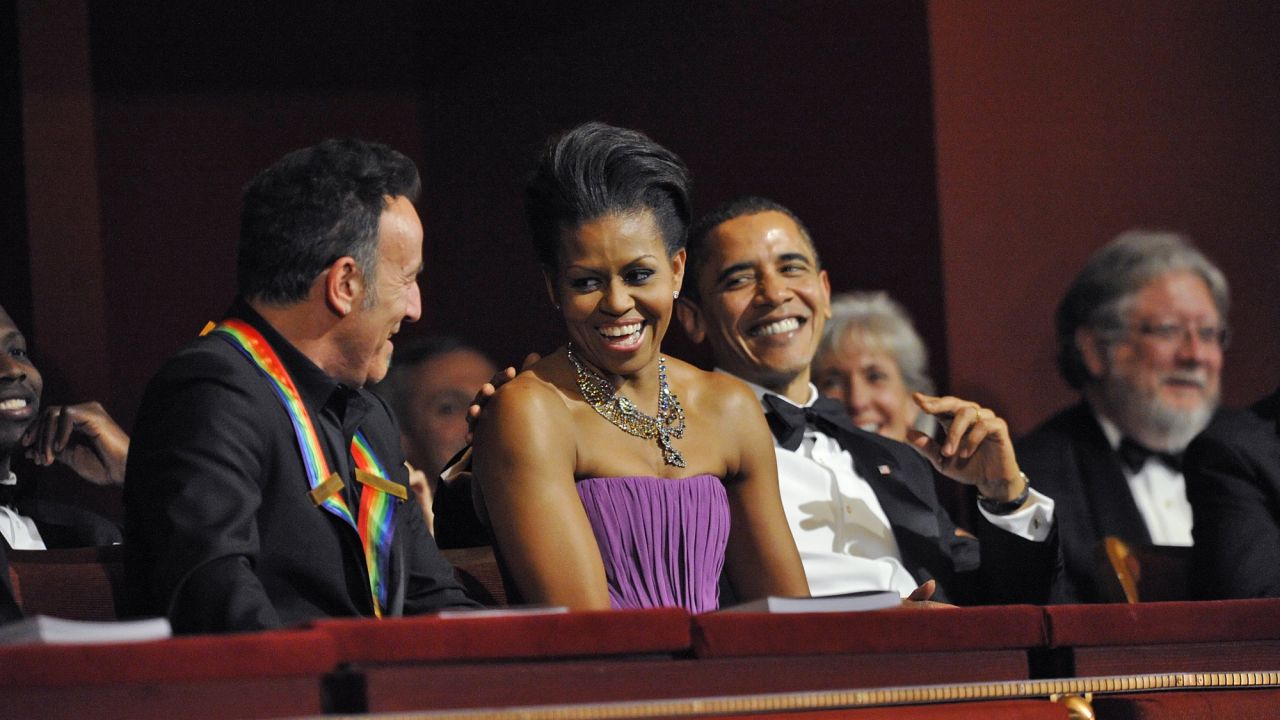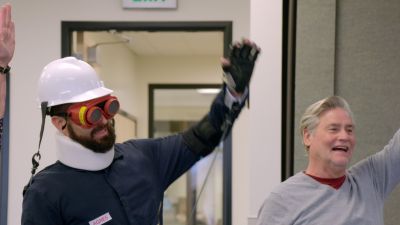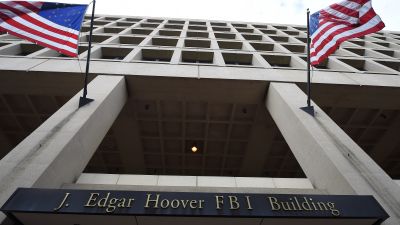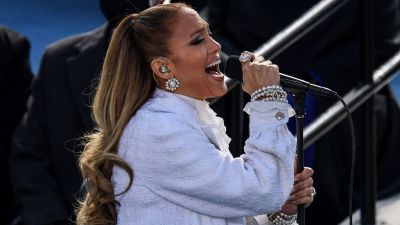
Rock Legend Bruce Springstein, first lady Michelle Obama and President Barack Obama at the 2009 Kennedy Center Honors. (Photo by John Paul Filo/CBS via Getty Images)
On August 3, long before the conflagration at Charlottesville marked a turning point in Donald J. Trump’s presidential career, Norman Lear threw down a gauntlet. Though Lear would accept the Kennedy Center honor to be awarded to him in December for his unique role in American society as the pioneering creator of politically charged situation comedies, he announced that he would not attend the White House reception preceding the event, a decision Lear said he made in protest of Trump’s denial of funding to the arts. (Trump has proposed the elimination of the National Endowment of the Arts and the National Endowment of the Humanities.)
The intervening days saw Trump equate the motives of anti-racism activists with those of the armed neo-Nazis and other white supremacists who took over the Virginia town to wreak mayhem that crescendoed to an act of domestic terrorism. Following rebukes of the president from military leaders and the defection of business leaders from two presidential commissions, the entire membership of the President’s Committee on the Arts and Humanities resigned from their posts with an artfully crafted letter in which the first letter of each paragraph spelled out the word “RESIST” in a vertical, all-caps column. In the letter, they called on the president to resign his office.
On Thursday, two days after Trump’s impromptu press conference at Trump Tower, dancer and choreographer Carmen de Lavallade, another Kennedy Center honoree, announced she would also sit out Trump’s reception. She did so, she wrote in a statement, “in light of the socially divisive and morally caustic narrative that our current leadership is choosing to engage in, and in keeping with the principles that I and so many others have fought for. …”
Then Saturday brought word that the president and the first lady would not attend the Kennedy Center Honors ceremony, a nationally televised affair at which the president traditionally addresses the assembled who’s who of political and entertainment power circles, and says something nice about each of the honorees, who are selected by a committee of which he is not a member. The honorees also make remarks. For Trump, who can’t abide a note of criticism, attendance at the event would have been fraught indeed.
Trump’s refusal to attend this year’s ceremony is a bigger deal than it might initially appear, given the turmoil and chaos his administration has laid upon the country since the president’s willfully divisive and insulting inaugural address. The Kennedy Center Honors ceremony is one of the nation’s foremost celebrations of American arts and culture, and one aimed at a broad viewing audience. (This year, all but one of the five awardees are people of color.) Only rarely have presidents bowed out, usually due to important foreign policy events, and never before “to allow the honorees to celebrate without any political distraction,” as an August 19 statement from the White House described as the reason for the Trumps’ withdrawal from the event.
Authoritarian leaders nearly always find artists to be problematic, save for those few willing to contort their artistic impulse to serve the authoritarian’s needs. Artists are unruly; you never know quite what they’ll do. That’s why we all stay glued to the screen into the wee hours on Academy Awards night, why a Golden Globes award ceremony can turn into a political moment. It’s not for nothing that Trump has announced his opposition to funding the National Endowments for the Arts and Humanities. The people who receive support from those institutions are unlikely to sign a loyalty oath to Donald J. Trump.
Trump’s contempt for the arts is amply demonstrated in the White House’s events calendar. Typically, by this point in his presidency, a commander-in-chief, together with the first lady, would have presided over an East Room concert by an American superstar. George W. and Laura Bush celebrated jazz master Lionel Hampton; the Obamas gathered stars to honor composer and musician Stevie Wonder. The only performing artists Trump has invited to the White House so far appear to be Kid Rock and Ted Nugent, who once threatened to assassinate Barack Obama, whom he called “a subhuman mongrel,” and suggested that Obama “suck on my machine gun.” What Nugent said about former Democratic presidential candidate Hillary Clinton is not printable here. In April, Trump had the pair, joined by former Republican vice presidential nominee Sarah Palin, to dine with him and mock a portrait of Hillary Clinton.
By the time the Trumps withdrew from the Kennedy Center event, Susan Bro, whose daughter was killed in a motor vehicle attack by a white supremacist in Charlottesville on August 12, told ABC News that she would not take a phone call from the president of the United States, given the president’s indictment of left-wing counterprotesters as being no better than the neo-Nazis they had come to oppose. (Although the president did describe James Alex Fields Jr., the driver of the car that plowed into a group of peaceful protesters, killing Bro’s daughter, Heather Heyer, as “a disgrace to himself, his family and his country,” he declined to describe Fields’ attack on the crowd as an act of terrorism.)
Given this trajectory, it’s not hard to see why Trump would cower at the specter of a lecture from Norman Lear, a 95-year-old Jewish man, beloved by Americans for his creation of such television characters as Archie and Edith Bunker and George and Louise Jefferson. Perhaps Lear would talk about his time in a bomber over Europe, when he served as an Army Air Force gunner, having enlisted in the wake of the attack on Pearl Harbor. Or speak with pride of his co-founding of the advocacy group People for the American Way, which tracks right-wing attacks on democracy. Maybe he would upbraid the president for his starving of the arts, or address the flames of racial division the president has been fanning, race being a topic that is often central to Lear’s television shows and other projects. Or Lear might do none of these things. The event is scheduled for December 3, so who knows what we’ll be talking about then.
And what of the other honorees, who include de Lavallade, Lionel Richie, Gloria Estefan and LL Cool J (the latter being the first hip-hop artist so honored)? What might they say? For Donald J. Trump, to be in their presence — and powerless to shut them up — would indeed be a moment fraught with peril.
If Trump’s refusal to take his place in the Kennedy Center Honors proves anything, it’s the power that artists hold when they choose to wield it. Artists in the realm of popular entertainment can shape the ideas and outlook of ordinary people to an extraordinary degree. One need only look to how Norman Lear’s sitcoms brought the issues of the day into American living rooms, during the time of day when families gathered together around their TV sets.
Individual acts of dissent, such as Lear’s snubbing of an invitation from the president, are powerful in and of themselves. So, too, are the organized acts of artists and their supporters who are less known to the broader public, as is the case with the President’s Committee on the Arts and Humanities.
Just imagine, then, what power performing artists and behind-the-scenes powerhouses might have if they came together to organize everyday people. They could play a pivotal role in saving the republic from the despotic oligarchy it seems destined to become in the age of Trump (assuming it hasn’t become such already).
Artists and storytellers who live closer to the ground have been organizing as part of the resistance since the day after the election. In January, PEN America convened a panoply of writers and poets on the steps of the New York Public Library amid a crowd outfitted with posters designed by artist and writer Molly Crabapple. In November, the cast of Hamilton confronted Vice President-elect Mike Pence from the stage with a direct appeal stating the cast’s fears that the incoming administration “would not protect” the rights of people from racial and ethnic minorities. Last January in Washington, DC, a small parade of jazz musicians, some with instruments in hand, protested Trump’s attack on the NEA, whose minuscule slice of the federal budget — 0.013 percent, according to Quartz — largely goes to organizations that bring the arts to underserved communities.
These protests, pleadings and acts of dissent hopefully serve as harbingers of even greater acts of resistance to come from the nation’s arts communities. A coordinated strategy among top-name artists, such as that employed by leading artists in the civil rights era, could spur regular people to action. If we examine the work, both in the spotlight and behind the scenes, of Harry Belafonte, Miriam Makeba, Ruby Dee and Ossie Davis, and Dick Gregory (whose August 19 passing we mourn today), we find a group of artists who collaborated in protest and deployed themselves strategically to expand the civil rights movement.
At the vanguard of nearly every successful liberation movement, artists have led the way. With America on the verge of capture by the forces of unbridled greed — avarice enabled by the stoking of racial and ethnic hatred — the nation is in dire need of liberation. And Donald J. Trump, the ringmaster of those forces, cowers before the power of America’s artists.
Trump’s demonstrated contempt for the arts displays not only disregard for the common culture of the American people, but his ongoing assault on anyone who speaks out against him. The president’s attacks on both the press and the arts rely on implements from the authoritarian toolkit.
If the actions of Kennedy Center honorees Norman Lear and Carmen de Lavallade spur fellow artists to similar protests, that will be a powerful thing. And if artists seize the moment to mobilize the resistance movement already underway, the movement will be unstoppable. One could scarcely imagine a worse nightmare for the artless Donald J. Trump, and the destructive and divisive forces he represents.




